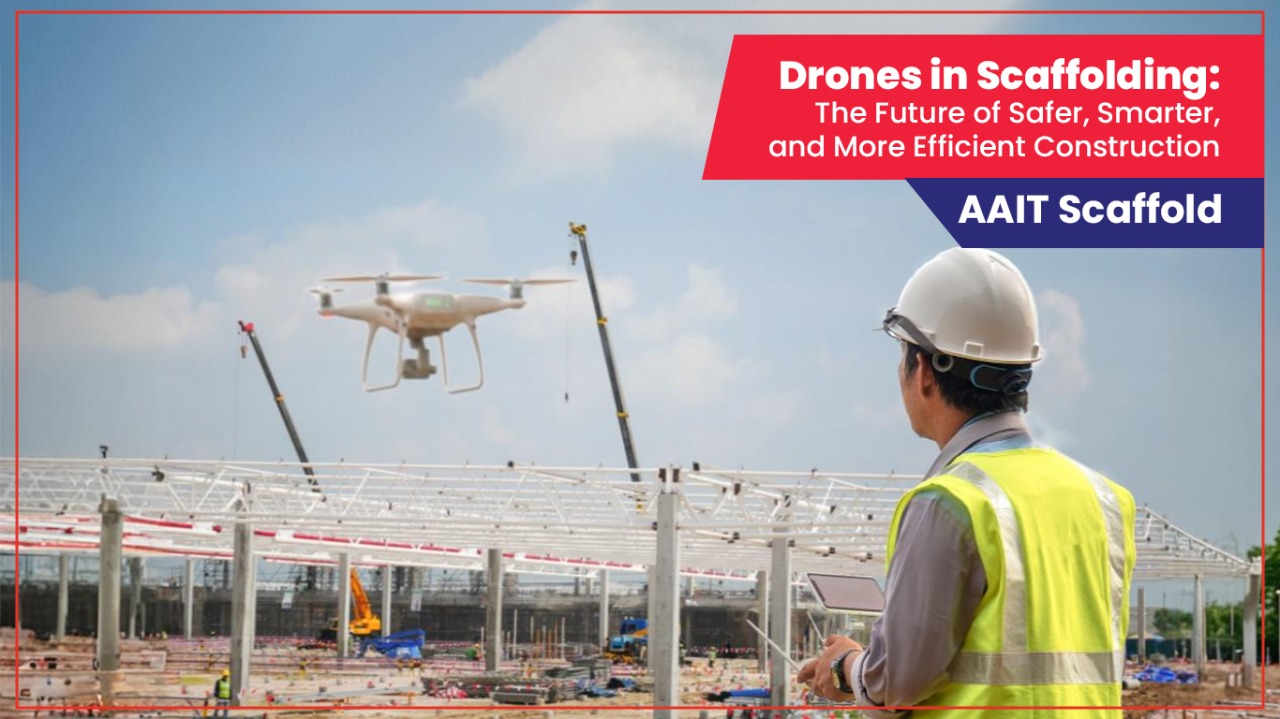
The scaffolding industry has always been an innovator as it looks for new materials and technologies to enhance its safety, efficiency and productivity. One of these innovations is certainly drones in scaffolding operations, and that is the introduction of drones in all aspects of scaffolding – from planning and supervising the fabrication and installation of scaffolding to monitoring the job site’s environmental conditions and creating advertising videos of completed projects for marketing. Drones are changing the way scaffolding works and improving safety and efficiency in the process.
Drones, officially recognized as Unmanned Aerial Vehicles (UAVs), are taking scaffolding operations to a whole new level! Drones are changing everything. Whether they are used for site surveys, real-time inspections or something else, drones are creating efficiencies in processes that previously took longer, were unsafe, and were expensive. Take a look at how drones are changing scaffolding operations and the advantages created.
How Drones are Transforming Scaffolding Operations
Drones are changing scaffolding operations by providing high-quality data from the air that affects project timelines, safety procedures, and overall cost management. Here is the list of how drones in scaffolding operations are changing everything.
1. Site Surveys and Planning with Drone Technology
Traditionally, scaffolding companies would rely on manual site inspections to gather information for their planning and design stages. These surveys often involved workers physically climbing to high or hard-to-reach areas, which could be dangerous and time-consuming. Drones can survey an entire site in a fraction of the time while keeping workers safely on the ground.
Drones equipped with advanced cameras and LiDAR (Light Detection and Ranging) technology are capable of capturing highly detailed, three-dimensional aerial data. This information can then be fed into digital modeling software, allowing scaffolding designers to create accurate and efficient scaffolding plans. By using drones in scaffolding, the planning stage becomes faster, more precise and far safer, as it eliminates the need for on-site personnel to be exposed to potentially hazardous conditions.
The impact of drone on site surveys:
1) Speed: Surveys are completed much faster than traditional methods.
2) Accuracy: Drones provide highly detailed, accurate data.
3) Safety: Workers are not exposed to dangerous heights during surveys.
2. Drone Inspections for Scaffolding Safety Compliance
Ensuring the safety and structural integrity of the scaffolding is critical to any construction project. In the past, scaffolding inspections required workers to climb the scaffolds, risking falls and accidents. Drones are now providing an alternative method for conducting inspections, allowing businesses to carry out checks from a safe distance.
Using drones equipped with high-definition cameras and thermal sensors, inspectors can identify potential issues in scaffolding structures without ever needing to leave the ground. Drones can detect problems such as misaligned components, weak points, or areas that may be at risk of failure. By catching these issues early, companies can prevent costly repairs or, worse, a potential accident on site.
How drones in scaffolding enhance inspection
1) Real-time data: Drones provide instant access to visual and thermal data for inspection
2) Improved Safety: No need for workers to climb scaffolds during inspections.
3) Proactive Maintenance: Early detection of structural issues can prevent larger problems later.
3. Improving Construction Site Safety with Drones
Construction site safety is a top priority, especially when working with scaffolding. The risk of falls from height remains one of the leading causes of accidents in the construction industry. Drones play a crucial role in minimizing the risk by allowing businesses to conduct inspections and surveys without requiring workers to work at height.
Drones enable construction teams to carry out detailed site surveys or scaffold inspections without needing workers to physically climb scaffolds or navigate hazardous areas. This significantly reduces the likelihood of accidents and injuries, leading to a safer working environment for all the employees.
Key safety benefit of drones in scaffolding
1) Reduced risk of falls: Drones eliminate the need for workers to climb scaffolds.
2) Safer Inspection: Drones enable inspections of difficult-to-reach areas safely.
3) Reduced downtime: With faster inspections, projects experience fewer safety delays.
4. Reducing Costs and Increasing Efficiency with UAVs
One of the most compelling reasons to adopt drones in scaffolding operations is the cost and time savings. Drones reduce the need for manual labor, speeding up workflows and minimizing downtime. This increased efficiency directly translates into cost reduction for businesses.
By enabling quick and efficient site surveys, inspection and data collection, drones streamline project timelines. With fewer personnel required to carry out dangerous tasks and less time spent on manual inspections, businesses can cut labor costs and reduce the need for expensive scaffolding repairs or accidents caused by overlooked issues.
How do drones boost efficiency and cut costs?
1) Faster workflows: Drones complete tasks in a fraction of the time it takes manually.
2) Lower labor costs: Reduced needs for workers to conduct dangerous inspections or surveys.
3) Fewer delays: Swift data collection and analysis reduce project downtime.
Embrace the Future of Scaffolding with AAIT
The integration of drones in scaffolding operations is transforming the way the industry approaches planning, safety and efficiency. By utilizing UAV technology, businesses can improve site surveys, enhance scaffolding inspections, and streamline operations, all while reducing costs and minimizing risks.
At AAIT Scaffold, we are committed to embracing the latest innovations in the scaffolding industry. By providing cutting edge scaffolding solutions and staying at the forefront, we are helping our clients improve their operations while prioritizing safety and efficiency.












 Download
Download
Comments are closed